Numerical Investigations of a Tip Turbine Aerodynamic Design in a Propulsion System for VTOL Vehicles
Abstract
:1. Introduction
2. Conventional Design of the Tip Turbine
2.1. Structural Characteristics of the ADFTT Rotor
2.2. Performance Estimation of the Tip Turbine
2.3. Profile Design of the Tip Turbine by the Conventional Method
3. Numerical Investigations of the Tip Turbine Designed by the Conventional Method
3.1. CFD Method
3.2. CFD Results and Flow Field Analysis
3.3. Energy Extraction Rate Analysis
4. Numerical Investigations of the Tip Turbine Designed by the High-Reaction Method
4.1. Principle of the High-Reaction Method
4.2. Flow Field Analysis
4.3. Energy Extraction Rate Analysis
5. Conclusions
- Conventional design methods are not suitable for tip turbine designs with low solidity. Under a low-solidity condition, the performance of a tip turbine will be greatly reduced, including the pressure ratio, efficiency, and energy extraction rate, resulting in an inadequate energy extraction capability.
- The high-reaction method can successfully solve the problems caused by low solidity in a tip turbine. The distribution of the energy extraction rate is more uniform and the value is higher. In this study, compared with the conventional method, the high-reaction method improved the isentropic work by 71.9% under the low-solidity condition (from 10.28 kW/kg to 17.67 kW/kg) and the isentropic efficiency increased from 80.0% to 85.6%, meaning the performance of the tip turbine met the design requirements.
- The tip turbine designed by the high-reaction method could form a complete flow path in an aerodynamic extending way. A Laval-tube-type flow tube could be found in the rotor flow field, which was formed by the wall boundary of the suction surface and the shear boundary of the wake. Therefore, the rotor could organize the airflow effectively.
Author Contributions
Funding
Acknowledgments
Conflicts of Interest
References
- Marin, N.; Spataru, P. The role and importance of UAV within the current theaters of operations. INCAS Bull. 2010, 2, 66–74. [Google Scholar]
- Li, N. The US army ten key techniques needed for next warfare. New Time Def. 2011, 12, 1–8. (In Chinese) [Google Scholar]
- Przedpelski, Z. Lift Fans for Advanced V/STOL Aircraft. In Proceedings of the Low-Speed Flight Meeting, Montreal, QC, Canada, 18–19 October 1965. [Google Scholar]
- Hunziker, K.S. X-32 Aeroservoelasticity. In Proceedings of the 44th AIAA/ASME/ASCE/AHS Structures, Structural Dynamics, and Materials Conference, AIAA-2003-1882, Norfolk, Virginia, 7–10 April 2003. [Google Scholar]
- Zimbrich, R.A.; Colehour, J.L. An investigation of Very High Bypass Ratio Engines for Subsonic Transports. In Proceedings of the Propulsion Specialist Conference, Paper No. 88-2953, Boston, MA, USA, 11–13 July 1988. [Google Scholar]
- Kutney, J. Aerothermodynamic Considerations of the Tip Turbine Driving Lift/cruise Fan Propulsion System. In Proceedings of the AIAA Summer Meeting, Los Angeles, CA, USA, 17–20 June 1963. [Google Scholar]
- Ronald, G. Lift-fan aircraft: Lessons learned from XV-5 flight experience. In Proceedings of the International Powered Lift Conference, Santa Clara, CA, USA, 1–3 December 1993. [Google Scholar]
- Asmus, F.J. Design and Development of the Tip Turbine Lift Fan. Ann. N. Y. Acad. Sci. 2010, 107, 147–176. [Google Scholar] [CrossRef]
- Anthony, G.; George, L.; James, H. Fan-in-wing technology, from the XV-5A to the present. In Proceedings of the International Powered Lift Conference, Los Angeles, CA, USA, 12–14 August 2013. [Google Scholar]
- Nobuhiro, T. Development Study on Air Turboramjet. AIAA Paper. Available online: https://arc.aiaa.org/doi/10.2514/5.9781600866401.0259.0331 (accessed on 15 June 2019).
- Hatta, H.; Kogo, Y.; Tanatsugu, N.; Mizutani, T.; Ohnabe, H. Application of advanced carbon-carbon composites to a tip turbine structure of the ATREX engine. In Proceedings of the 36th Structures, Structural Dynamics and Materials Conference, New Orleans, LA, USA, 10–13 April 1995. [Google Scholar]
- Haas, J.E.; Kofskey, M.G.; Hotz, G.M.; Futral, S.M., Jr. Cold-Air Performance of a Tip Turbine Designed to Drive a Lift Fan. I—Baseline Performance; NASA TM X-3452; NASA: Washington, DC, USA, 1978.
- Haas, J.E.; Kofskey, M.G.; Hotz, G.M. Cold-Air Performance of a Tip Turbine Designed to Drive a Lift Fan. IV—Effect of Reducing Rotor Tip Clearance; NASA TP-1126; NASA: Washington, DC, USA, 1978.
- Bond, W.H. Collection Based Combined Cycle for Earth to Orbit Propulsion. In Proceedings of the 44th AIAA Aerospace Sciences Meeting and Exhibit, AIAA-2006-217, Reno, Nevada, 9–12 January 2006. [Google Scholar]
- Casado, H.; Cristobal, E.; Lorido, A.; Ramsden, K.W. A Tip-Turbine Driven Propulsion Fan Concept. In Proceedings of the ASME Turbo Expo 2002: Power for Land, Sea, and Air, Amsterdam, The Netherlands, 3–6 June 2002; pp. 877–885. [Google Scholar]
- Huang, G.; Xiang, X.; Xia, C.; Lu, W.; Li, L. Feasible Concept of an Air-Driven Fan with a Tip Turbine for a High-Bypass Propulsion System. Energies 2018, 11, 3350. [Google Scholar] [CrossRef]
- Gallimore, S.J. Axial Flow Compressor Design. Proc. Inst. Mech. Eng. 1999, 213, 437–449. [Google Scholar] [CrossRef]
- Shepherd, D.G. Principles of Turbomachinery; Macmillan: London, UK, 1956. [Google Scholar] [CrossRef]
- Menter, F.R. Two-equation eddy-viscosity turbulence models for engineering applications. AIAA J. 1994, 32, 1598–1605. [Google Scholar] [CrossRef] [Green Version]
- Zhang, J.; Fu, S. An efficient approach for quantifying parameter uncertainty in the SST turbulence model. Comput. Fluids 2019, 181, 173–187. [Google Scholar] [CrossRef]


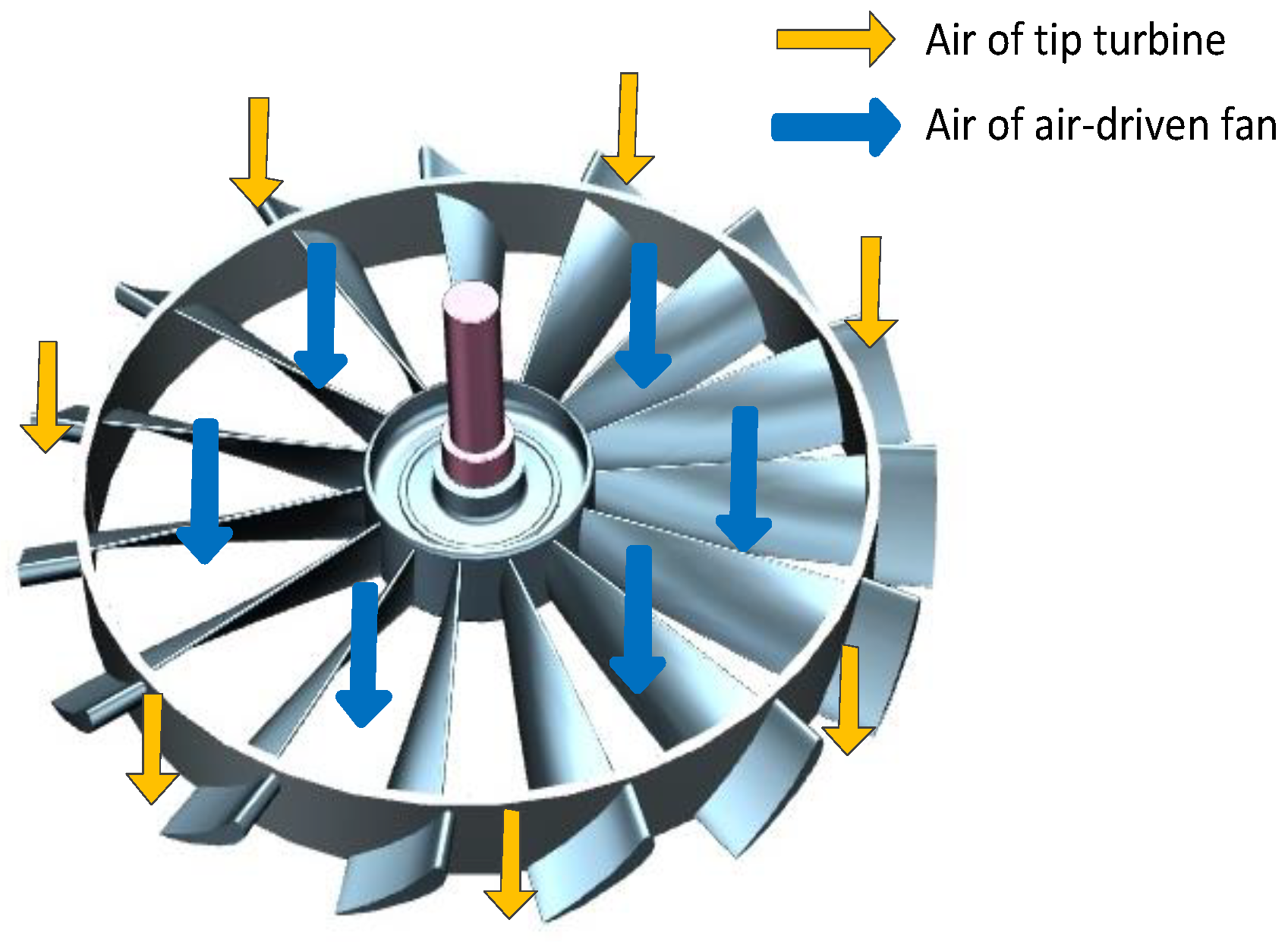
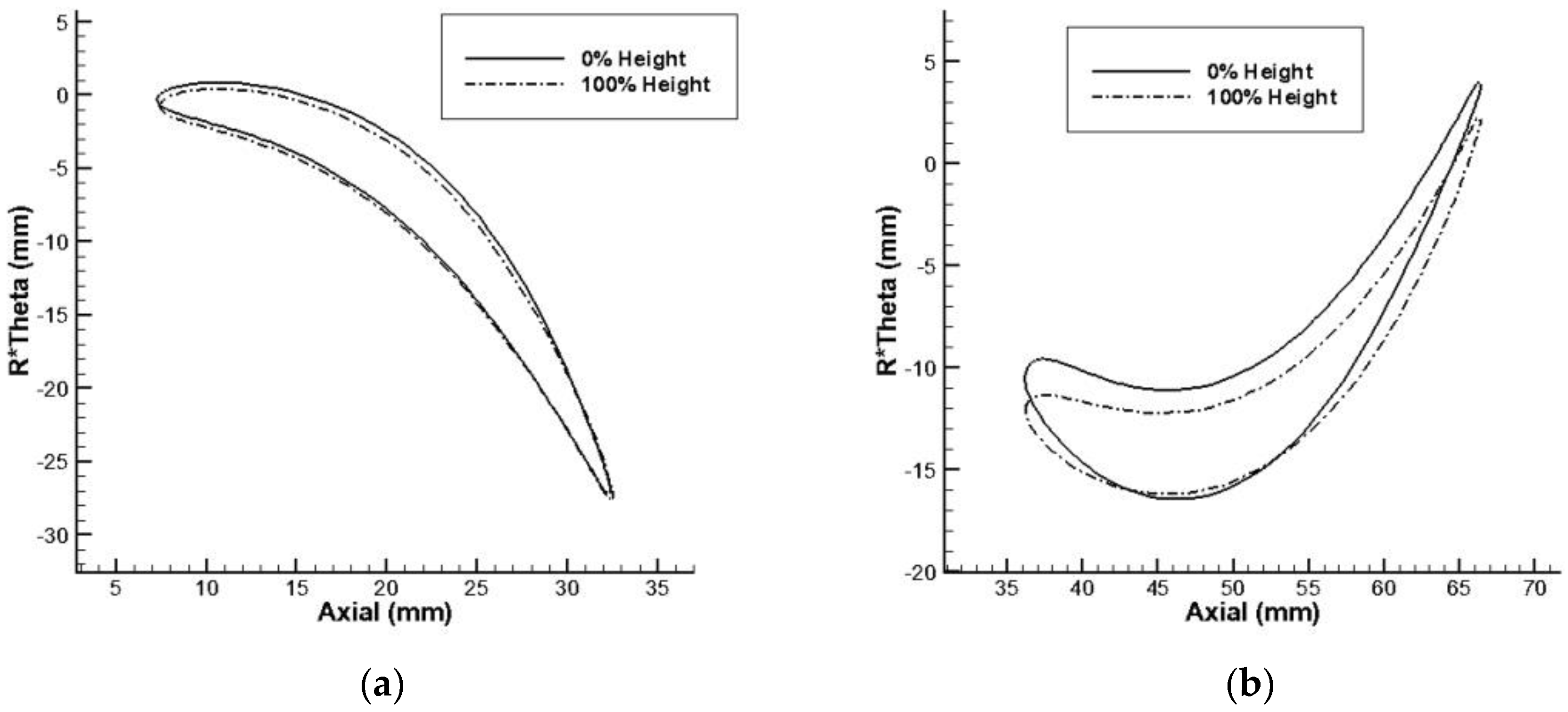

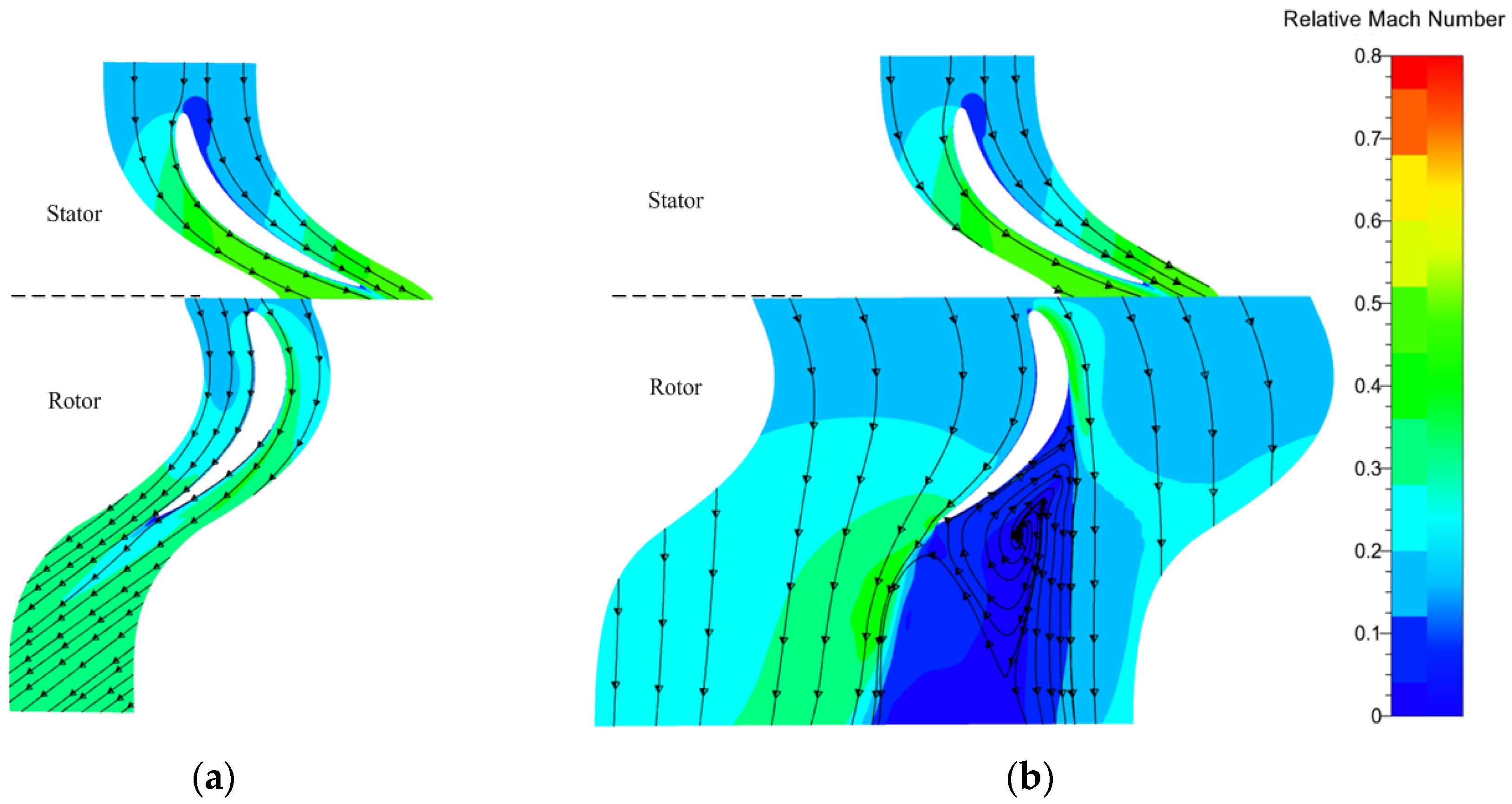
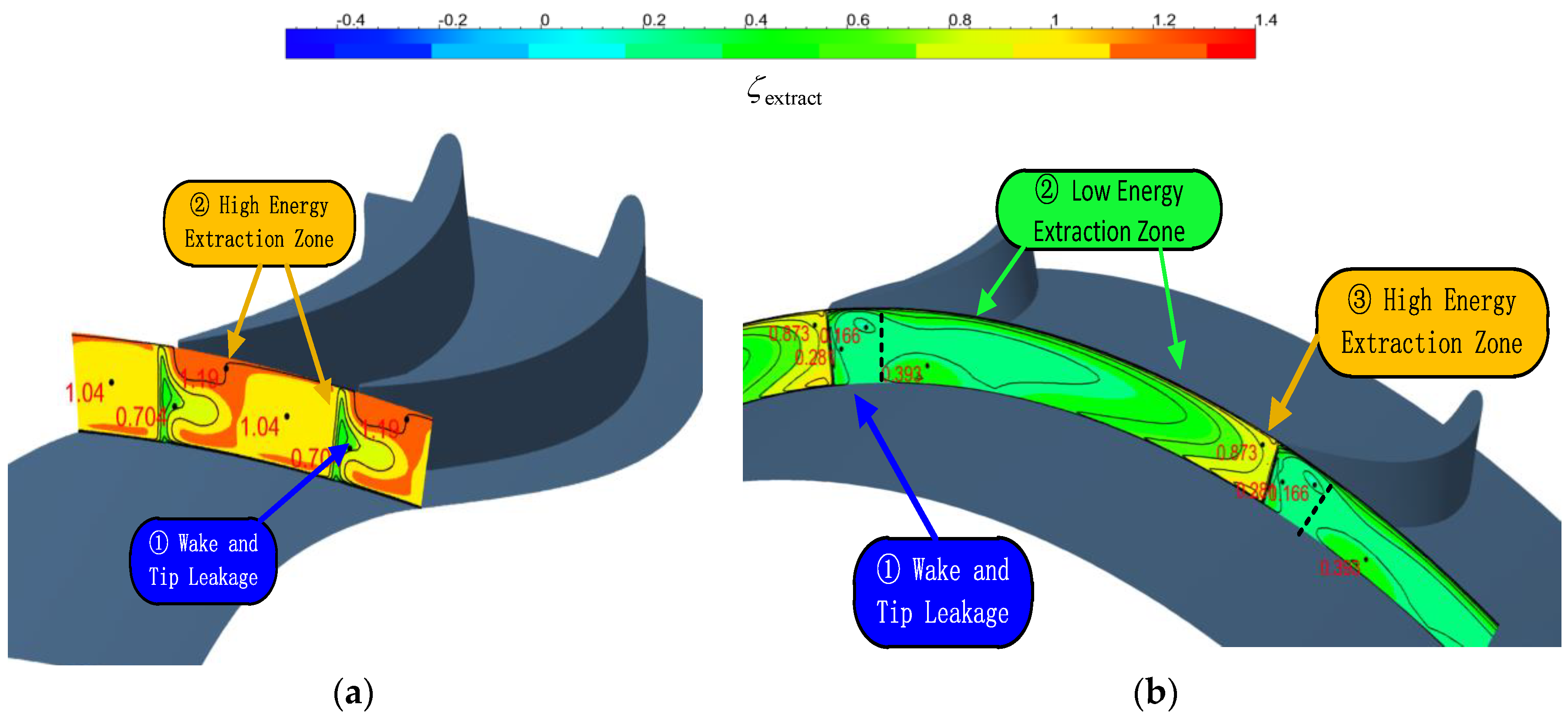


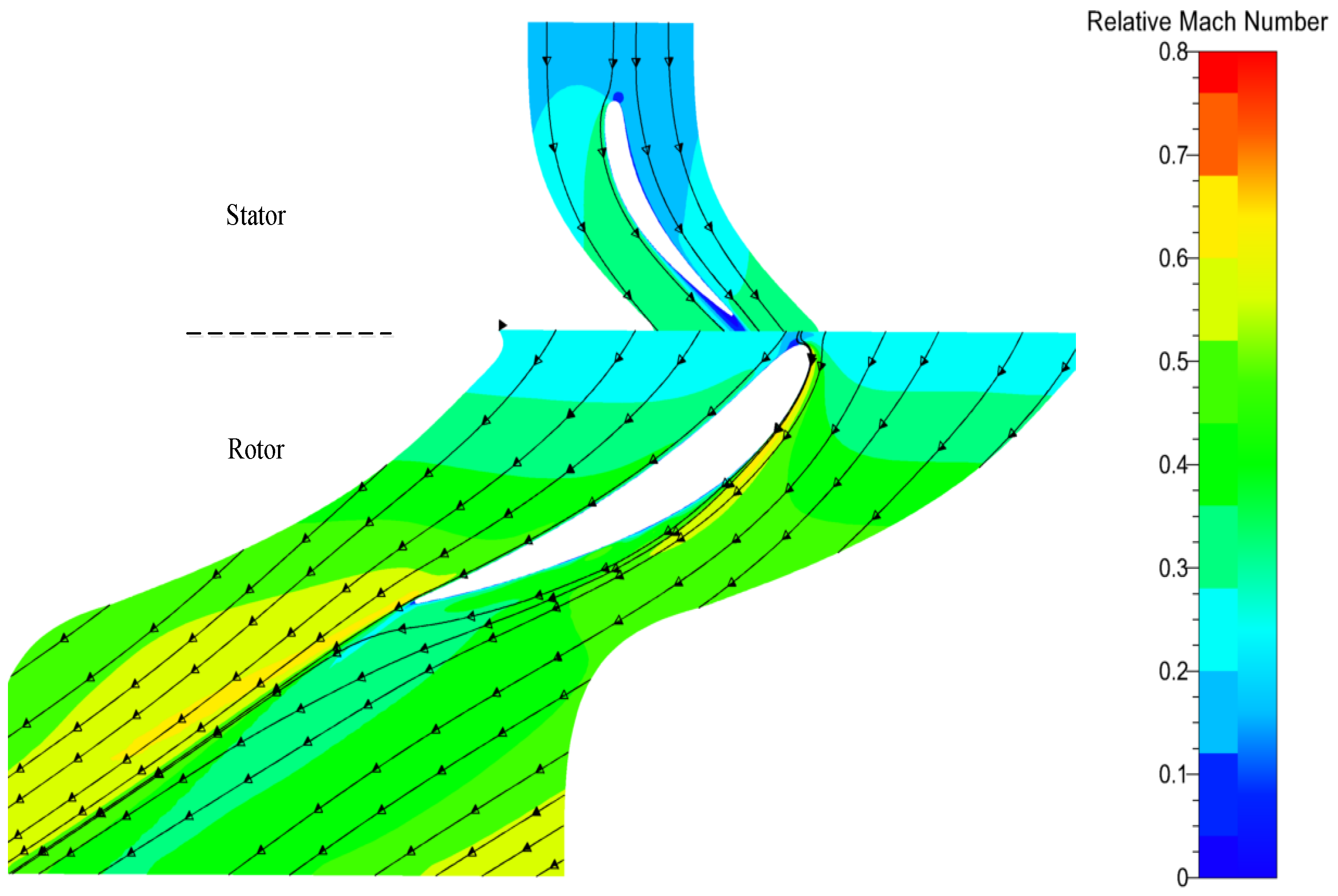




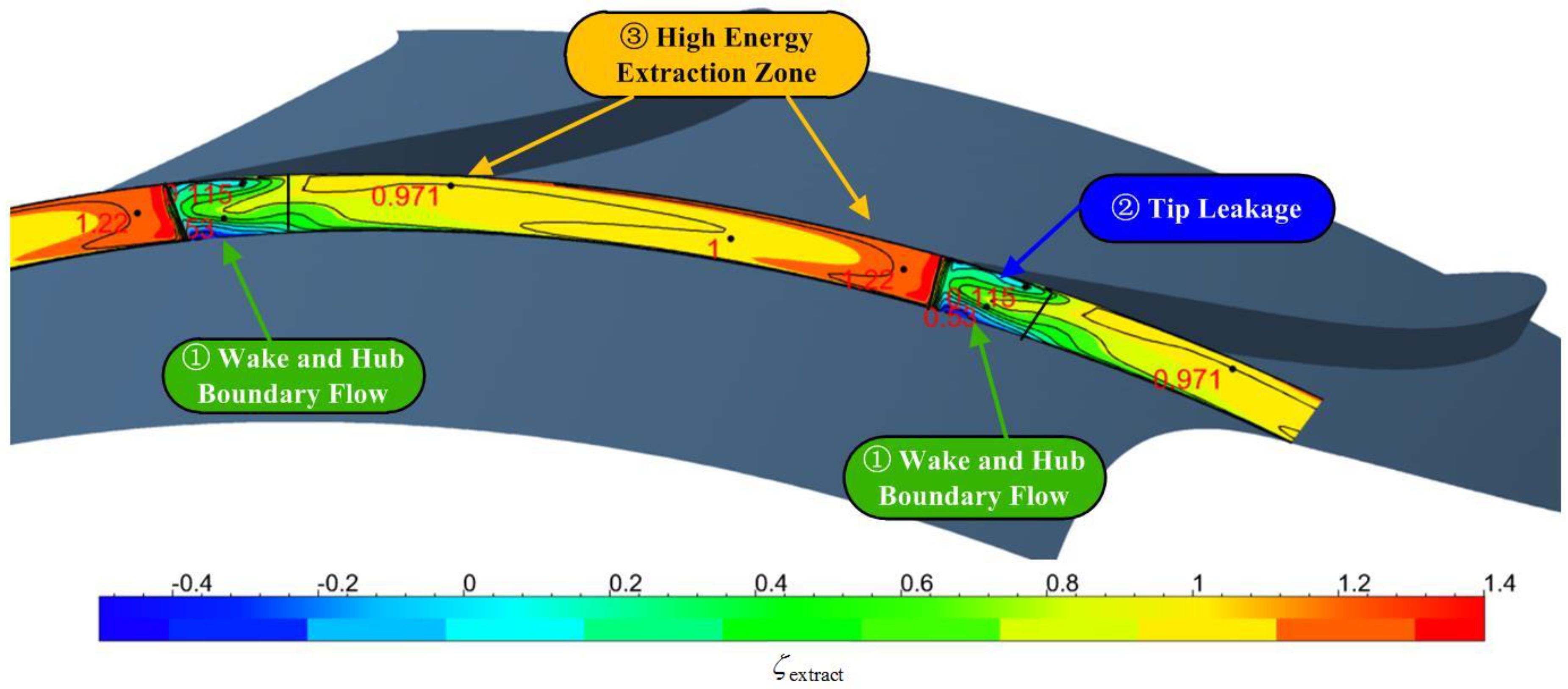
| Parameter (Unit) | Tip Turbine | Air-Driven Fan |
|---|---|---|
| Inlet total pressure (Pa) | 122,080 | 101,325 |
| Inlet total temperature (K) | 444 | 288 |
| Mass flow rate (kg/s) | 0.56 | 5.01 |
| Isentropic efficiency (%) | 85.0 | 85.0 |
| Pressure ratio | 1.18 | 1.02 |
| Thrust 1 (DaN) | - | 32.9 |
| Parameter (Unit) | Stator | Rotor |
|---|---|---|
| Hub diameter (mm) | 336 | 336 |
| Shroud diameter (mm) | 354 | 354 |
| Rotational speed (rpm) | 0 | 7500 |
| Axial length (mm) | 25 | 30 |
| Solidity (chord/space) | - | 1.7 |
| Inlet flow angle (°) | 0 | −10.2 |
| Outlet flow angle (°) | 70 | 57.2 |
| Reaction degree | 0.38 | |
| Parameter (Unit) | Design Requirements | Conventional Solidity | Low Solidity |
|---|---|---|---|
| Number of rotor blade | - | 57 | 13 |
| Mass flow rate (kg/s) | 0.56 | 0.556 | 0.577 |
| Pressure ratio | 1.180 | 1.191 | 1.108 |
| Isentropic efficiency (%) | 85.0 | 85.9 | 80.0 |
| Isentropic work (kW/kg) | 17.57 | 18.7 | 10.28 |
| Relative deflection angle (°) | - | 85 | 41 |
| Parameter (Unit) | Stator | Rotor |
|---|---|---|
| Hub diameter (mm) | 339 | 339 |
| Shroud diameter (mm) | 354 | 354 |
| Rotational speed (rpm) | 0 | 7500 |
| Axial length (mm) | 25 | 30 |
| Solidity(chord/space) | - | 0.74 |
| Inlet flow angle (°) | 0 | 42.8 |
| Outlet flow angle (°) | 42.2 | 66.3 |
| Reaction degree | 0.99 | |
| Parameter (Unit) | Design Requirements | High-Reaction Design |
|---|---|---|
| Number of rotor blade | - | 13 |
| Mass flow rate (kg/s) | 0.56 | 0.56 |
| Pressure ratio | 1.180 | 1.180 |
| Isentropic efficiency (%) | 85.0 | 85.6% |
| Isentropic work (kW/kg) | 17.57 | 17.67 |
| Relative deflection angle (°) | - | 32.4 |
© 2019 by the authors. Licensee MDPI, Basel, Switzerland. This article is an open access article distributed under the terms and conditions of the Creative Commons Attribution (CC BY) license (http://creativecommons.org/licenses/by/4.0/).
Share and Cite
Xiang, X.; Huang, G.; Chen, J.; Li, L.; Lu, W. Numerical Investigations of a Tip Turbine Aerodynamic Design in a Propulsion System for VTOL Vehicles. Energies 2019, 12, 3003. https://doi.org/10.3390/en12153003
Xiang X, Huang G, Chen J, Li L, Lu W. Numerical Investigations of a Tip Turbine Aerodynamic Design in a Propulsion System for VTOL Vehicles. Energies. 2019; 12(15):3003. https://doi.org/10.3390/en12153003
Chicago/Turabian StyleXiang, Xin, Guoping Huang, Jie Chen, Lei Li, and Weiyu Lu. 2019. "Numerical Investigations of a Tip Turbine Aerodynamic Design in a Propulsion System for VTOL Vehicles" Energies 12, no. 15: 3003. https://doi.org/10.3390/en12153003





